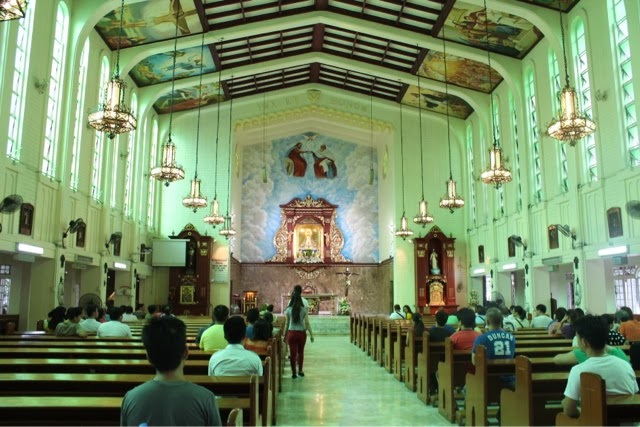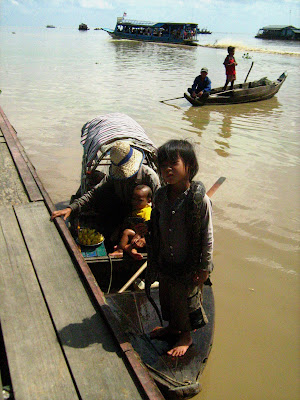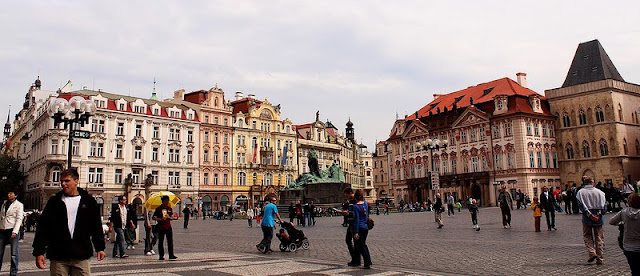 |
| The new |
I remember my mother used to tell me that the place to be seen in the 1950s was Escolta in downtown Manila, while Ermita -- considered a major cultural and financial hub in the city of Manila at the time -- was the go-to place for the government offices and various business establishments.
People would go to Ermita for leisurely walks at Luneta (Rizal Park), to visit the nearby National Museum, or to transact business at government offices like the columned edifices of the Supreme Court and the Court of Appeals, the Department of Tourism, the Legislative Building (now the branch of the National Museum housing the National Art Gallery). Ermita was also peppered with art nouveau and art deco buildings and stately homes, this being the site of many second homes of the wealthy as early as the late 1800s.
But today, baby boomers can only say with much regret that Manila has seen better days, and the Ermita that they now see is far different from what it was during its heyday.
In the 1970s, Ermita became notorious for the string of bars and night clubs that made it Manila’s red light district. To be fair, former Manila Mayor Alfredo Lim, during his term in the 1990s, tried his best to change Ermita’s image by getting rid of these notorious establishments.
Today Metro Manila denizens have simply exchanged Ermita for the posh, more developed Makati, Bonifacio Global City, Eastwood or Ortigas Center for obvious reasons.
The area’s once beautiful art nouveau buildings -- still being used by foreign exchange dealers, travel and overseas employment agencies, and run-of-the-mill art shops -- make a passerby think twice about entering due to their sorry states.
The sidewalks are filled with filth, while almost every corner is occupied by vagrants.
REBUILDING ERMITA
The city government of Manila is now making concrete steps to reclaim the city’s glory, beginning with Ermita.
Tour guide and cultural activist Carlos P. Celdran, who was also appointed Manila tourism consultant by former President and now Manila Mayor Joseph “Erap” Ejercito Estrada, has organized “barter” walking tours of the district, where participants give whatever they want in exchange for the tour.
The move was meant to pique people’s interest, and to show them that Ermita still holds promise as a leisure and tourist destination. It is also a way to gather feedback from the tour-goers as to what needs to be done to make the place come alive again.
And so one fine Sunday back in November, Mr. Celdran led a pack of about a hundred yuppies to check out what’s in store for them in Ermita.
“To revive our streets, we should put back things on the streets and not [keep them] inside the mall,” Mr. Celdran said at one of the tours.
Our first stop was Casa Tesoro on A. Mabini St., a stately art deco home that is now home to 1335 Mabini gallery that showcases sculptures, tribal art, and works by up-and-coming artists.
Right across Casa Tesoro is Munchen, which Mr. Celdran said should be considered a heritage restaurant for being the oldest German eatery in the country. He said that those with discerning palates looking for authentic German fare still frequent the place despite its rundown-looking façade.
The next stop was what was once called Marilou Apartments and is now known as the Lotus Garden Hotel, an art deco building that due to successful restoration and adaptive reuse, still has that old Manila feel in it with its cozy interiors and walls teeming with pictures of the Manila of yore.
Along M.H. del Pilar St. is the famous Hobbit House, another popular destination for its staff composed of “little people,” JRR Tolkien-inspired interiors, and, of course, the quality jazz acts.
And then there’s the Ermita Church, the very reason for the area’s name. “Ermita” comes from “La Hermita” or the hermitage -- that this church was. The church, founded in the 1600s, has undergone several face-lifts through the centuries, the last of which was in 1951 after it was razed by fire.
Close to the church is the Office Piano Bar, another iconic establishment in the area and arguably the oldest bar in Manila.
On the way to Luneta park, the group also passed by other iconic establishments -- the Solidaridad Bookstore of National Artist for Literature F. Sionil Jose, the Hiraya Art Gallery, and the Philamlife Building, an architectural gem from the 1950s. The Philamlife Auditorium, a favorite venue for orchestral, classical and choral performances as it has what is said to be the best acoustics in Metro Manila, is now the subject of controversy because of SM Development Corp.’s plan to construct a residential condominium on the site.
As we reached Rizal Park, Mr. Celdran changed his tone from regretful to excited given the recent enhancements at the park.
He said the park’s image as a haven for muggers, pickpockets and smooching lovers is slowly changing with a series of improvements -- for instance the renovation of the gardens, the installation of CCTV cameras, and the removal of eye-sore stores.
“Once upon a time, Luneta was one of the most dangerous places in Manila. Now it’s the safest,” Mr. Celdran said. “Luneta is the lungs, heart and soul of Manila. Luneta is where we should start change in Manila.”
At the tail end of the walking tour, we were brought to the newly restored 1912 beaux arts-style building that is now the boutique hotel called Luneta. Close by, the last stop on the tour was the Miramar Hotel, another art deco gem built during the 1930s along Roxas Blvd. which once belonged to the Ortigas family and now being run by the Pe family.
HOTELIERS, RESTAURATEURS, UNITE!
Efforts to revive Ermita are not limited to the government as the area’s business owners have teamed up to revive it.
Michelle M. Pe, vice-president of the Ermita Malate Business Owners Association (EMBOA), said business for hotels, restaurants and other establishments within the area is not that good as they feel the pinch of people’s preference for the more “chic” parts of Metro Manila.
“This was once a beautiful city. We would want to bring back the old Manila. Originally, this is the tourist destination. What makes this different from Makati is we have the heritage,” said Ms. Pe, who also manages Miramar Hotel, in an interview.
Recently, the sidewalks within Ermita and Malate were tidied up, while business owners were encouraged to look after their own premises and ensure cleanliness.
EMBOA, which consists mostly of hoteliers and restaurateurs, also donated bicycles to the Manila police to ensure police visibility at night, especially given that petty crimes are one of the turnoffs for tourists in Manila.
The group is also looking at the establishment of a private sector-run body similar to the Makati Commercial Estate Association (MACEA) that will oversee security concerns and ensure smooth traffic flow within the district.
And to further lure tourists to Ermita, business owners -- particularly the hotels -- now regularly come up with half-priced deals and promote “staycationing” in their properties.
“This is the capital. We have to show them what we’ve got,” EMBOA President Alberto L. Torrijos said in another interview.
Mr. Celdran’s job, however, doesn’t end with Ermita. He said reviving the whole of Manila is a tall order from the mayor.
While work is being done to bring back the glory of Manila, Mr. Celdran’s plea to Metro Manila residents and visitors, still, is to consider frequenting the other sites within the city that will definitely be worth their time and money.
“This is just half. There’s still Intramuros and Chinatown!” Mr. Celdran said.
*This article was published at the Weekender section of BusinessWorld on Dec. 27, 2013.
The move was meant to pique people’s interest, and to show them that Ermita still holds promise as a leisure and tourist destination. It is also a way to gather feedback from the tour-goers as to what needs to be done to make the place come alive again.
And so one fine Sunday back in November, Mr. Celdran led a pack of about a hundred yuppies to check out what’s in store for them in Ermita.
“To revive our streets, we should put back things on the streets and not [keep them] inside the mall,” Mr. Celdran said at one of the tours.
Our first stop was Casa Tesoro on A. Mabini St., a stately art deco home that is now home to 1335 Mabini gallery that showcases sculptures, tribal art, and works by up-and-coming artists.
Right across Casa Tesoro is Munchen, which Mr. Celdran said should be considered a heritage restaurant for being the oldest German eatery in the country. He said that those with discerning palates looking for authentic German fare still frequent the place despite its rundown-looking façade.
The next stop was what was once called Marilou Apartments and is now known as the Lotus Garden Hotel, an art deco building that due to successful restoration and adaptive reuse, still has that old Manila feel in it with its cozy interiors and walls teeming with pictures of the Manila of yore.
Along M.H. del Pilar St. is the famous Hobbit House, another popular destination for its staff composed of “little people,” JRR Tolkien-inspired interiors, and, of course, the quality jazz acts.
And then there’s the Ermita Church, the very reason for the area’s name. “Ermita” comes from “La Hermita” or the hermitage -- that this church was. The church, founded in the 1600s, has undergone several face-lifts through the centuries, the last of which was in 1951 after it was razed by fire.
 |
| Inside the Ermita Church. Ermita is named such as this church used to be called "La Hermita," or place for hermits. |
Close to the church is the Office Piano Bar, another iconic establishment in the area and arguably the oldest bar in Manila.
On the way to Luneta park, the group also passed by other iconic establishments -- the Solidaridad Bookstore of National Artist for Literature F. Sionil Jose, the Hiraya Art Gallery, and the Philamlife Building, an architectural gem from the 1950s. The Philamlife Auditorium, a favorite venue for orchestral, classical and choral performances as it has what is said to be the best acoustics in Metro Manila, is now the subject of controversy because of SM Development Corp.’s plan to construct a residential condominium on the site.
As we reached Rizal Park, Mr. Celdran changed his tone from regretful to excited given the recent enhancements at the park.
 |
| Artworks at one of the gardens within Rizal Park (Luneta). |
He said the park’s image as a haven for muggers, pickpockets and smooching lovers is slowly changing with a series of improvements -- for instance the renovation of the gardens, the installation of CCTV cameras, and the removal of eye-sore stores.
“Once upon a time, Luneta was one of the most dangerous places in Manila. Now it’s the safest,” Mr. Celdran said. “Luneta is the lungs, heart and soul of Manila. Luneta is where we should start change in Manila.”
At the tail end of the walking tour, we were brought to the newly restored 1912 beaux arts-style building that is now the boutique hotel called Luneta. Close by, the last stop on the tour was the Miramar Hotel, another art deco gem built during the 1930s along Roxas Blvd. which once belonged to the Ortigas family and now being run by the Pe family.
 |
| Miramar Hotel, an art nouveau gem at Roxas Boulevard, was also built in the 1930s. |
HOTELIERS, RESTAURATEURS, UNITE!
Efforts to revive Ermita are not limited to the government as the area’s business owners have teamed up to revive it.
Michelle M. Pe, vice-president of the Ermita Malate Business Owners Association (EMBOA), said business for hotels, restaurants and other establishments within the area is not that good as they feel the pinch of people’s preference for the more “chic” parts of Metro Manila.
“This was once a beautiful city. We would want to bring back the old Manila. Originally, this is the tourist destination. What makes this different from Makati is we have the heritage,” said Ms. Pe, who also manages Miramar Hotel, in an interview.
Recently, the sidewalks within Ermita and Malate were tidied up, while business owners were encouraged to look after their own premises and ensure cleanliness.
EMBOA, which consists mostly of hoteliers and restaurateurs, also donated bicycles to the Manila police to ensure police visibility at night, especially given that petty crimes are one of the turnoffs for tourists in Manila.
The group is also looking at the establishment of a private sector-run body similar to the Makati Commercial Estate Association (MACEA) that will oversee security concerns and ensure smooth traffic flow within the district.
And to further lure tourists to Ermita, business owners -- particularly the hotels -- now regularly come up with half-priced deals and promote “staycationing” in their properties.
“This is the capital. We have to show them what we’ve got,” EMBOA President Alberto L. Torrijos said in another interview.
Mr. Celdran’s job, however, doesn’t end with Ermita. He said reviving the whole of Manila is a tall order from the mayor.
While work is being done to bring back the glory of Manila, Mr. Celdran’s plea to Metro Manila residents and visitors, still, is to consider frequenting the other sites within the city that will definitely be worth their time and money.
“This is just half. There’s still Intramuros and Chinatown!” Mr. Celdran said.
*This article was published at the Weekender section of BusinessWorld on Dec. 27, 2013.






































